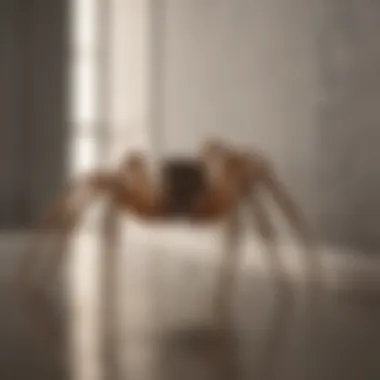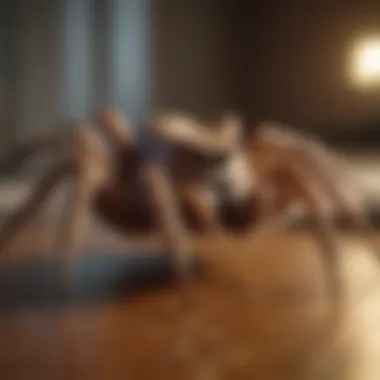House Spider Prevention: Effective Strategies for a Pest-Free Home


Intro
House spiders often find their way into our homes, seeking shelter, warmth, and food. Understanding these creatures is vital to prevent them from becoming unwelcome neighbors. Their presence can spark unease or fear, but spiders play a significant role in our ecosystem. They help control other pests, such as flies and mosquitoes. However, knowing how to manage their presence without resorting to harmful chemicals is essential for maintaining a pest-free environment.
This article will outline effective strategies for preventing house spiders. It will cover pest identification, various prevention methods, and DIY pest control solutions designed specifically for homeowners and those interested in sustainable living practices.
Pest Identification
Before implementing prevention methods, it is crucial to identify the common types of spiders that may invade your home. Understanding their behaviors can help you take more effective measures.
Common Household Pests
Among the most frequent house spiders, the following species can often be found in human dwellings:
- Common House Spider (Parasteatoda tepidariorum): Typically brown or gray, with a round body.
- Daddy Long Legs (Pholcus phalangioides): Known for its long legs and small body, it prefers dark, quiet areas.
- Jumping Spider (Salticidae family): Small and agile, these spiders are often found near windows or plants.
Signs of Infestation
Detecting a spider infestation early can prevent more significant issues. Signs to look for include:
- Webs: Often found in corners, behind furniture, or in window frames.
- Egg Sacs: Usually pearly or white, these can be spotted attached to surfaces.
- Sightings: Regularly observing spiders, especially larger ones, can indicate an infestation.
Prevention Methods
Once you have identified the possible presence of house spiders, the next step is employing prevention methods that can help keep your home spider-free.
Environmental Modifications
Adjusting the environment inside and outside your home is key to lowering spider attraction. Consider these strategies:
- Seal Cracks and Crevices: Use caulk to fill gaps around windows, doors, and the foundation.
- Remove Clutter: Reducing clutter in and around your home minimizes hiding spots for spiders.
- Maintain Gardens: Trim back shrubs and trees, ensuring they do not touch your home.
Home Maintenance Tips
Regular maintenance routines can significantly aid in spider prevention. Some effective tips include:
- Regular Cleaning: Vacuum frequently to remove webs, eggs, and even the spiders themselves.
- Proper Lighting: Use yellow or sodium vapor light bulbs outdoors to minimize insect attraction.
- Store Firewood Properly: Keep it stacked away from the home to reduce spider habitats.
DIY Pest Control Solutions
For those inclined towards home remedies, several DIY pest control solutions can be both effective and environmentally friendly.
Natural Remedies
Natural spider repellents can include:
- Essential Oils: Peppermint, tea tree, and citrus oils can deter spiders. Mix a few drops with water and spray in areas where spiders are commonly found.
- Vinegar: A mixture of equal parts vinegar and water can be an effective deterrent when sprayed in problem areas.
DIY Traps and Barriers
Creating physical barriers can help keep spiders at bay. Some simple trap options include:
- Sticky Traps: Place these in corners or along walls to capture wandering spiders.
- Homemade Traps: A simple trap can be made using a jar and a piece of paper. Place a small piece of bait inside the jar, cover it with paper, and wait for spiders to climb in.
By understanding the habits of house spiders and implementing these prevention techniques, homeowners can create a peaceful living environment that minimizes unwanted pests without compromising eco-friendliness.
Maintaining a pest-free home requires dedication and consistent efforts. Taking these simple steps can greatly reduce the presence of house spiders while fostering a healthier home environment.
Understanding House Spiders


Understanding house spiders is a crucial component for many homeowners seeking to maintain a pest-free environment. This section provides insight into various aspects of house spiders, highlighting their behaviors and ecological relevance. By gaining knowledge about these arachnids, one can take informed actions to either coexist with them or effectively minimize their presence in the home.
Defining House Spiders
House spiders are members of the Araneae order that have adapted to living in human structures. They exhibit diverse traits, but most commonly, they are not aggressive. Common characteristics include eight legs, a segmented body, and the ability to spin webs for trapping prey. While people often consider them pests, their presence can save homeowners from more troublesome insects.
Common Species Found Indoors
Several species of spiders are typically found indoors. Among the most prevalent are the common house spider, the cellar spider, and the black widow. The common house spider is often seen spinning webs in corners and is non-threatening. The cellar spider, known for its long legs and small body, prefers dark and damp areas such as basements. Meanwhile, the black widow, recognizable by its red hourglass marking, poses a threat as its bite can lead to serious health issues.
Ecological Role of Spiders
Spiders play a vital ecological role in controlling pest populations. They are considered natural pest controllers as they prey on various insects, reducing their numbers. This biological control maintains a balance in the ecosystem. Furthermore, spiders help to facilitate pollination indirectly by feeding on other insects that may disrupt pollination processes.
"Spiders serve essential functions in ecosystems by controlling insect populations and providing food for other wildlife."
In summary, understanding house spiders offers a pathway to coexistence and sets the stage for effective prevention strategies. Knowledge about house spider definitions, common species, and their ecological roles empowers homeowners to manage these creatures responsibly.
Identifying Spider Habitats
Understanding where spiders typically reside is crucial in developing effective prevention strategies. Identifying spider habitats allows homeowners to take informed measures in minimizing spider presence. House spiders usually prefer areas that provide suitable conditions to thrive. Recognizing these specific environments can enable individuals to take proactive steps toward a spider-free home.
Typical Hiding Places
Spiders tend to favor certain locations within a home. Common hiding spots include:
- Corners of rooms: Spiders find the undisturbed, dark corners appealing.
- Basements and attics: These areas often have less foot traffic, providing a safe haven.
- Storage boxes and cluttered spaces: Items stacked or stored without regular movement make ideal shelters.
- Behind furniture: Large pieces often create secluded areas for spiders to hide.
Being mindful of these locations can help in maintaining cleanliness and order within the home. Regular inspections in these areas can significantly reduce the likelihood of spider infestations.
Factors Influencing Spider Presence
Several factors contribute to why spiders choose to inhabit a particular area. Key influences include:
- Availability of food: A presence of insects like flies or moths can attract spiders. Reducing food sources makes the home less welcoming.
- Moisture levels: Spiders usually prefer humid environments. Areas prone to leaks or high humidity can foster spider populations.
- Seasonal changes: During certain seasons (like autumn), spiders may seek shelter indoors as temperatures drop.
- Landscaping considerations: Outdoor plants or debris close to the house can encourage spiders to move inside.
By understanding these factors, homeowners can make informed decisions about their interior maintenance and outdoor management.
"By addressing the common causes of spider attraction, one can maintain a significant reduction in their presence at home."
Awareness of such influences leads to more effective and sustainable pest management practices.
Preventive Measures
Preventive measures are critical in keeping homes free from house spiders. These strategies not only assist in minimizing spider presence but also contribute to a more comfortable living environment. By taking proactive steps, homeowners can effectively reduce potential habitats where spiders thrive. Implementing such measures requires understanding the behaviors and preferred environments of house spiders.
Sealing Entry Points
Sealing entry points is one of the most effective strategies to prevent house spiders from entering. Spiders find their way indoors through small cracks and gaps. These can be in windows, doors, and even foundations. To effectively seal these entryways:
- Inspect doors and windows for gaps. Weather stripping can serve as an excellent barrier against spiders.
- Use caulk to fill in any cracks in the walls, particularly around utility lines and where two building materials intersect.
- Check screens for tears or holes. Repair or replace damaged screens to minimize exposure.
By ensuring that these potential entry points are sealed, homeowners can significantly decrease the chances of spiders taking up residence within their spaces.
Maintaining Cleanliness
Another vital aspect of spider prevention is cleanliness within the home. Spiders are attracted to areas that provide shelter and food. Therefore, maintaining a clean environment reduces their attraction to your home. Consider the following:
- Regularly dust and vacuum areas, especially corners and less frequented spots where spiders may build webs.
- Remove clutter such as old boxes and clothes that can serve as hiding places.
- Store food properly in sealed containers to limit access to potential food sources for spiders and their prey.


Keeping the home clean not only deters spiders but also enhances overall hygiene, thus improving quality of life.
Landscaping Considerations
Landscaping plays an indirect but significant role in spider prevention. The exterior environment can influence the number of spiders that may approach your home. To manage landscaping effectively:
- Trim shrubs and vegetation away from the house to minimize the number of hiding spots for spiders.
- Avoid using mulch close to the foundation, as it can attract insects, which in turn draw spiders.
- Maintain a clean yard, removing debris like fallen leaves and wood piles that could attract spiders.
Taking proactive landscaping measures can noticeably reduce the visibility of spiders and other pests, fostering a more spider-free environment.
Utilizing Natural Deterrents
Utilizing natural deterrents is vital in creating a pest-free home. These methods not only provide effective strategies against house spiders but also align with eco-friendly practices. By choosing natural solutions, homeowners can avoid the use of harsh chemicals that can affect indoor air quality and overall health. Furthermore, natural deterrents emphasize prevention rather than reaction, making them a smart choice for long-term spider management.
Essential Oils and Natural Repellents
Essential oils serve as a potent alternative when preventing house spiders. Oils such as peppermint, tea tree, lavender, and eucalyptus contain compounds known to repel spiders effectively. When used correctly, they can create an environment that is less inviting for these arachnids.
- Peppermint Oil: Often regarded as one of the most effective agents, peppermint oil has a strong scent that spiders dislike. Simply mix a few drops with water in a spray bottle and apply it around entry points and areas where spiders are commonly seen.
- Tea Tree Oil: This oil not only repels spiders but also has antifungal properties. A mixture of tea tree oil and water can be used in the same way as peppermint oil.
- Lavender Oil: Known for its soothing aroma, lavender is pleasant for humans but aversive for spiders. This oil can be utilized in various forms, including sprays or as an addition to sachets placed around the home.
- Eucalyptus Oil: Eucalyptus oil can also hinder spider activity. Like the others, this can be diluted in water and sprayed in key areas.
These oils can be combined with other natural ingredients, like vinegar, to enhance their repelling qualities. While these oils are effective, it is important to frequently reapply them to maintain their efficacy.
Plants That Repel Spiders
Incorporating certain plants that naturally repel spiders can be a practical approach to pest prevention. Several indoor and outdoor plants provide an aesthetic benefit while acting as a barrier against these pests.
Some effective plants include:
- Mint: This herb is not only delightful for cooking but emits a strong scent that repulses spiders.
- Lemongrass: Known for its invigorating fragrance, lemongrass is another great option. Its lemony scent can deter many insects, including spiders.
- Sage: This aromatic herb can be grown indoors or outdoors. Burning sage can also help to repel spiders from an area temporarily.
- Rosemary: This plant is easy to care for and serves as a natural deterrent. Its pungent smell is unappealing to spiders and other pests.
It is essential to note that while these plants can help deter spiders, they should be considered a part of an overall strategy. Regular watering, trimming, and proper placement of these plants will ensure their health and effectiveness in keeping spiders away.
"Using natural deterrents not only prevents spiders but also enhances the living environment."
Establishing both essential oils and spider-repelling plants in your home can lead to a significant reduction in spider presence while promoting a sustainable approach to pest management. These methods underscore the importance of preventative measures for a healthy and pest-free living space.
Monitoring and Maintenance
Monitoring and maintenance play a critical role in ensuring a long-term strategy for spider prevention within homes. Regular assessments enable homeowners to identify potential issues before they manifest into full-blown infestations. The primary benefits of maintaining vigilance in this regard include the early identification of spider habitats and the assurance of preventive measures being effectively implemented.
Incorporating a systematic approach to monitoring will empower residents to maintain a pest-free environment. This encompasses regular inspections of both indoor and outdoor spaces, as well as meticulous upkeep of the home’s structure.
Regular Inspections
Conducting regular inspections in both the interior and exterior of the home is essential for identifying signs of spider activity. These inspections should ideally occur on a monthly basis, focusing on areas where spiders are likely to hide. Such spots include corners, basements, attics, and seldom-used rooms.
During inspections, look for webs, egg sacs, and any signs of actual spiders. If evidence of spider activity is found, take immediate action to investigate further and implement removal strategies. Engaging with every room in the house can help to prevent larger infestations. Also, keeping an eye on window screens and sealing any gaps will assist in keeping spiders at bay.
"Regular inspections can offer peace of mind and prevent a small issue from escalating into a larger one."
Maintaining Outdoor Spaces
Maintaining outdoor spaces is equally as important as indoor inspections. Spiders thrive in environments that provide shelter and moisture. Therefore, pruning vegetation away from the home’s foundation and ensuring that grass and shrubs do not encroach upon pathways can significantly reduce conducive environments for spiders.
Here are a few practices to consider for outdoor maintenance:
- Reducing clutter: Keep outdoor objects like garden tools, firewood, or compost heaps organized. Clutter can attract pests, which in turn draw spiders.
- Cleaning gutters: Regularly clear debris from gutters and downspouts. This helps to prevent standing water, which can attract insects.
- Utilizing proper lighting: Outdoor lighting can attract insects. Opt for yellow bug lights or fully shielded lamps to reduce this issue.
By prioritizing monitoring and maintenance, homeowners can effectively mitigate the risk of spider infestations and maintain a more pleasant living environment.


Coping with Infestations
Addressing spider infestations effectively is essential for maintaining a comfortable and pest-free home environment. Recognizing the signs of an infestation and implementing removal strategies can significantly reduce the likelihood of future spider problems. This section explores how to identify an infestation and discusses various effective removal methods.
Identifying an Infestation
Before tackling a spider issue, it is crucial to discern whether an infestation exists. Key signs include:
- Webs: The presence of webs, particularly in corners or hidden areas, often indicates spider activity.
- Egg Sacs: Finding small, round sacs hidden in corners or near webs can signal an impending spider population increase.
- Sightings: Frequent encounters with live spiders, especially larger species, suggest a higher spider density in the vicinity.
- Droppings: Small black dots or grayish substances in hidden corners may be spider droppings.
Being vigilant about these signs can allow homeowners to act quickly, before the situation escalates.
Effective Removal Strategies
Once an infestation is confirmed, several removal strategies can be employed:
- Vacuuming: Using a vacuum cleaner to remove spiders, webs, and egg sacs can provide immediate relief. Ensure to dispose of the vacuum bag outdoors to prevent reinfestation.
- Natural Remedies: Solutions such as vinegar mixed with water or essential oil sprays can deter spiders. These methods are eco-friendly and preferable for those averse to chemical solutions.
- Insecticides: If the infestation is severe, using a targeted insecticide may be necessary. Choose products designed for spiders and follow the application instructions carefully to ensure safety.
- Professional Services: In cases of extreme infestations, it may be best to contact pest control professionals. They can assess the situation and provide a comprehensive treatment plan, including integrated pest management tactics
"Proactive measures and prompt action are critical in managing house spider infestations effectively."
The combination of identifying signs of an infestation and implementing appropriate removal techniques can keep your home spider-free. understanding the different methods available can empower homeowners to choose the best approach tailored to their specific situation. This not only ensures a comfortable living space but also fosters a sustainable and safe environment.
The Role of Pest Control Professionals
Pest control professionals play a pivotal role in managing house spider populations. Their expertise can provide homeowners with tailored solutions that align with the unique needs of each situation. Understanding when to seek their help and what methods they use is essential for effective management.
When to Seek Professional Help
Recognizing the signs that your home might need professional pest control assistance is crucial. If you detect a notable increase in spider activity or find egg sacs, this is a strong indicator of an infestation. Additionally, if you are uncertain about the species present and the potential risks they may pose, enlisting a professional’s expertise becomes invaluable.
Another consideration is the extent of the infestation. In some cases, DIY methods may provide short-term relief but fail to address the root cause. Professionals have access to a wide range of products and methods, including those that are more effective for severe infestations. They can also identify conditions in your home that might be attractive to spiders, which can help in preventing future issues.
Integrated Pest Management (IPM)
Integrated Pest Management (IPM) is a strategic approach that many pest control professionals adopt. This method combines various management techniques for effective and eco-friendly control of pests, including spiders.
IPM starts with thorough inspection and monitoring. This phase is critical for understanding the specific spider species and their behavior. Based on these insights, professionals will create a tailored management plan that emphasizes long-term prevention rather than just immediate removal.
Benefits of IPM include:
- Environmentally friendly solutions. By using a combination of biological, cultural, and chemical methods, IPM minimizes the impact on beneficial insects and the environment.
- Cost-effectiveness. Long-term results mean reduced need for repeated treatments, saving homeowners money over time.
- Sustainable practices. Focusing on prevention and monitoring ensures that spider populations are kept in check without relying solely on pesticides.
Overall, engaging with pest control professionals utilizing IPM not only address immediate concerns but contribute to a healthier home environment. It reflects a proactive approach to pest management that prioritizes sustainability and effectiveness.
Epilogue
The conclusion serves as a critical component of this article as it encapsulates the essence of house spider prevention techniques. Effective prevention not only enhances the comfort of a home but also promotes a healthier living environment. Understanding the behaviors of house spiders, the habitats they thrive in, and how to implement preventive measures can significantly reduce their presence.
Summarizing Prevention Techniques
In reviewing the various strategies discussed in this article, several key prevention techniques emerge as crucial for homeowners seeking a pest-free living space.
- Sealing Entry Points: Ensure that gaps in windows and doors are properly sealed. Look for cracks in walls and foundation as well.
- Maintaining Cleanliness: Regularly clean areas where spiders are likely to hide, such as attics, basements, and behind furniture.
- Utilizing Natural Deterrents: Consider using essential oils such as peppermint and lavender, which can help in deterring spiders.
- Outdoor Maintenance: Trim vegetation away from the home, as overgrown plants can provide a pathway for spiders to enter.
These techniques highlight the importance of a proactive approach. Implementing these methods will lower the chances of spiders taking residence in your home, ensuring a more comfortable and safe environment.
Emphasizing Sustainable Practices
Sustainable practices in managing house spiders not only benefit your home but also the surrounding ecosystem. It is essential to adopt eco-friendly methods for spider prevention.
- Natural Solutions: Using natural repellents reduces the need for harsh chemicals that may harm other beneficial insects and wildlife.
- Promoting Biodiversity: Allowing for a natural balance in your yard can minimize pest issues. Healthy ecosystems naturally regulate spider populations.
- Long-Term Management: Focus on integrated pest management, which combines multiple strategies for long-term success without detrimental effects on the environment.
Adopting sustainable practices showcases a commitment to responsible home management. These methods assist in maintaining a balanced ecosystem while ensuring house spiders remain outside where they belong.
"The goal of spider prevention is not just pest control; it's about creating a harmonious living space that respects nature."
In summary, through a combination of effective prevention techniques and sustainable practices, homeowners can achieve a pest-free environment, contributing to their peace of mind and overall household well-being.















